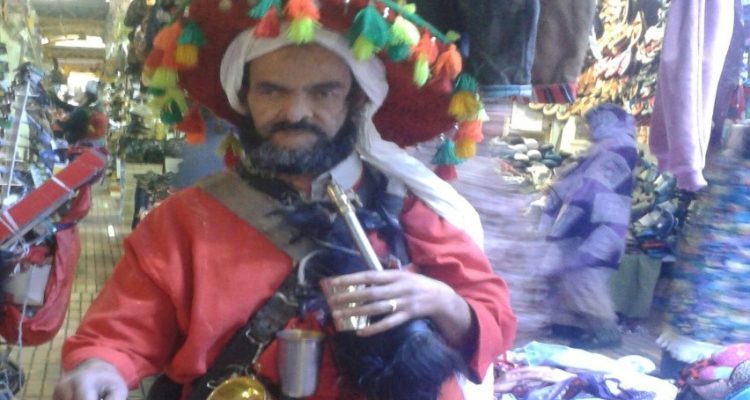
Inzegane, Morocco (Meryam Hayyan)– In the midst of Inzegane’s souq right in its crowded hallways, a familiar bell echoes through the walls; a sound resonated most with the thirsty costumers who had a long day barging to buy all sorts of merchandises. Mohamed Essalhi, a 59-year-old man whose tired face tells a thousand story, his visible wrinkles grey hair and wise eyes indicates that life was everything but easy for him, has been working as a “grab” since 1984 he sells water for a living; chilling water mixed with tar substance “Qatran,” well preserved in a goat leather holder. He wakes up every day at 8am, puts on his long red rope along with a white pants, and finishes his uniform with a big red Mexican like hat decorated with colorful straps that matches his traditional red shoes “Balgha”; he fetches his gear that consists of a long belt that goes around the shoulder attached with chains which holds together his copper cops along with his most important tool; his golden bell. Once he’s all dressed up, he hits the road by 10am. You see him wandering the Inzgane souq with the same smile he had 32 years ago; it has been three decades for this beloved “grab” serving customers and accepting whatever dimes he’d been given; dimes by which he sends his kids to school and pays all sorts of bills. Now the struggle is real for this “grab” as he doesn’t see or hear well. He only hopes people will hear the cries of his bell. Reminiscing the good old days, Mohamed says: “once there was too many of us, we were all buddies in this profession, we felt blessed.., now nobody seems to stop and enjoy a simple glass of water and eventually “grabas” started to look for other jobs”.
Mohammed thought about quitting too but he holds a great love for his job. It thought him how to live simple and how to be content with whatever God gave him. This old dedicated “grab” is among the very few “graba” left who still didn’t give up on their job; a job that once was appreciated and treated with both respect and gratitude. The art of “tagrabt” is important as it represents a deep rooted heritage of our culture, but unfortunately this trait of our culture and heritage is being now forgotten. We are slowly forgetting the sound of their bells, the taste of their water, and most of all their smile that never fails to meet our hearts. Let’s remind ourselves that “grabas” are our Moroccan Santa as there’s no greater gift than the gift of water.
Meryam Hayyan


